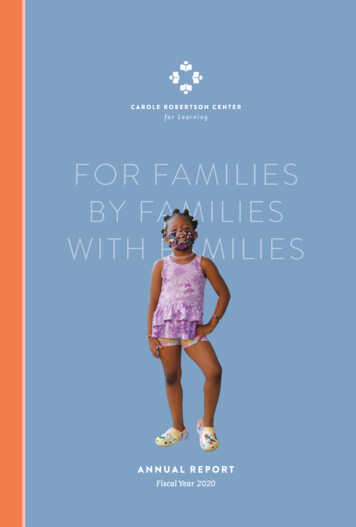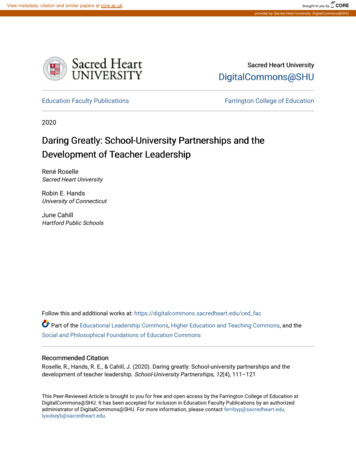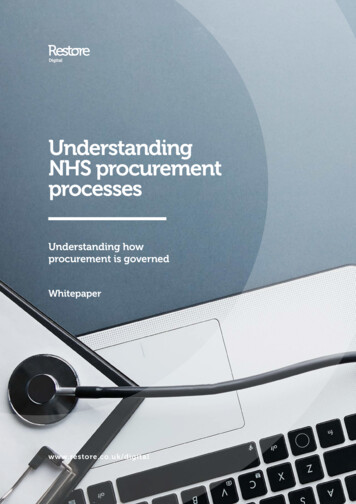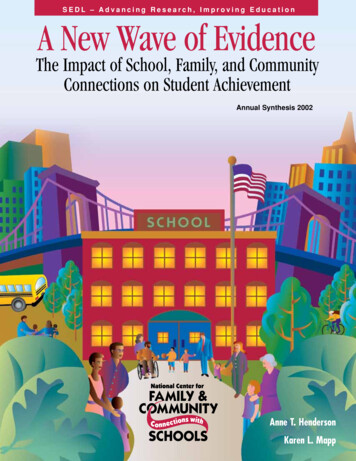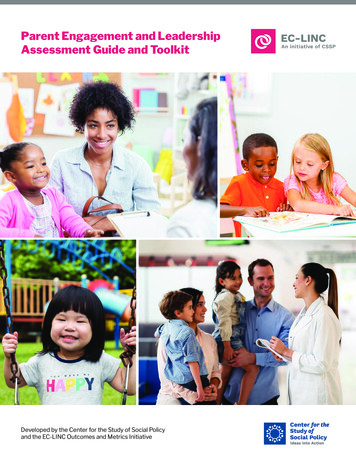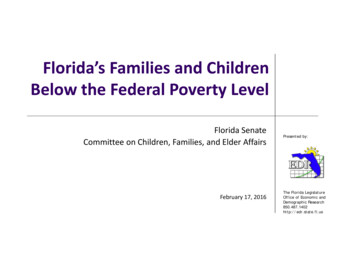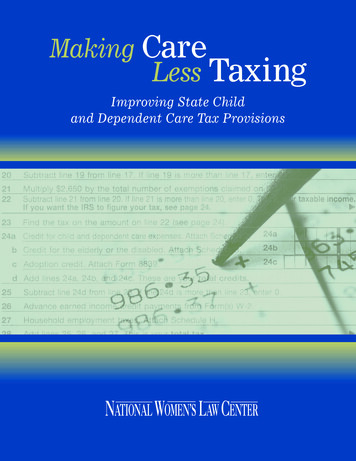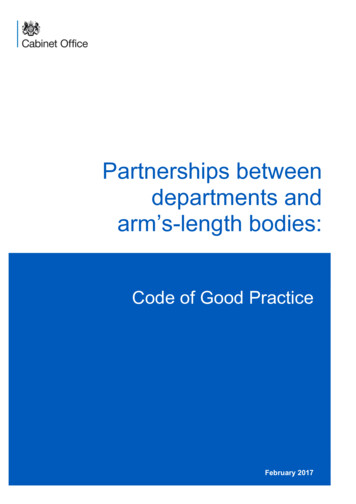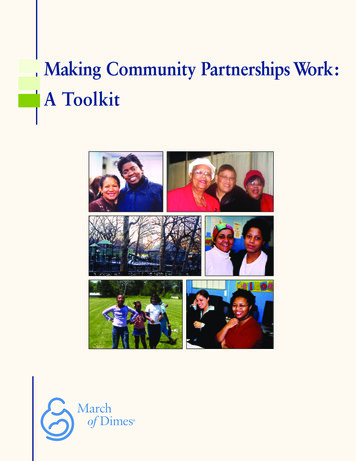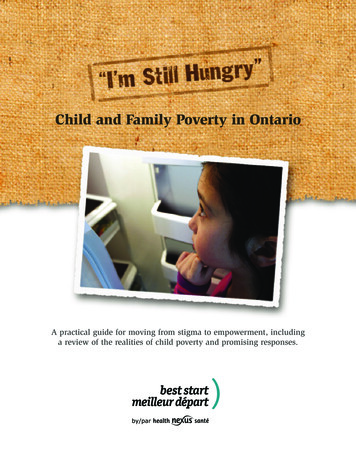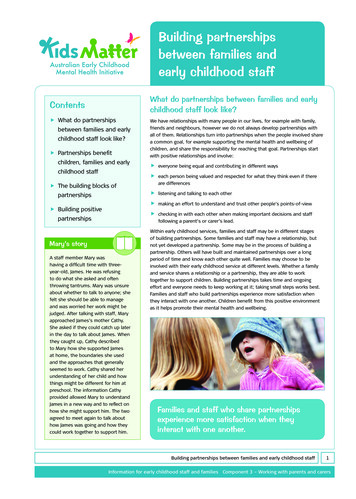
Transcription
Building partnershipsbetween families andearly childhood staffWhat do partnerships between families and earlychildhood staff look like?Contentsf What do partnershipsbetween families and earlychildhood staff look like?f Partnerships benefitchildren, families and earlychildhood staffWe have relationships with many people in our lives, for example with family,friends and neighbours, however we do not always develop partnerships withall of them. Relationships turn into partnerships when the people involved sharea common goal, for example supporting the mental health and wellbeing ofchildren, and share the responsibility for reaching that goal. Partnerships startwith positive relationships and involve:feveryone being equal and contributing in different waysfeach person being valued and respected for what they think even if thereare differencesflistening and talking to each otherfmaking an effort to understand and trust other people’s points-of-viewfchecking in with each other when making important decisions and stafffollowing a parent’s or carer’s lead.f The building blocks ofpartnershipsf Building positivepartnershipsMary’s storyA staff member Mary washaving a difficult time with threeyear-old, James. He was refusingto do what she asked and oftenthrowing tantrums. Mary was unsureabout whether to talk to anyone; shefelt she should be able to manageand was worried her work might bejudged. After talking with staff, Maryapproached James’s mother Cathy.She asked if they could catch up laterin the day to talk about James. Whenthey caught up, Cathy describedto Mary how she supported Jamesat home, the boundaries she usedand the approaches that generallyseemed to work. Cathy shared herunderstanding of her child and howthings might be different for him atpreschool. The information Cathyprovided allowed Mary to understandJames in a new way and to reflect onhow she might support him. The twoagreed to meet again to talk abouthow James was going and how theycould work together to support him.Within early childhood services, families and staff may be in different stagesof building partnerships. Some families and staff may have a relationship, butnot yet developed a partnership. Some may be in the process of building apartnership. Others will have built and maintained partnerships over a longperiod of time and know each other quite well. Families may choose to beinvolved with their early childhood service at different levels. Whether a familyand service shares a relationship or a partnership, they are able to worktogether to support children. Building partnerships takes time and ongoingeffort and everyone needs to keep working at it; taking small steps works best.Families and staff who build partnerships experience more satisfaction whenthey interact with one another. Children benefit from this positive environmentas it helps promote their mental health and wellbeing.Families and staff who share partnershipsexperience more satisfaction when theyinteract with one another.Building partnerships between families and early childhood staff1Information for early childhood staff and families Component 3 – Working with parents and carers
Partnerships benefit children, families and earlychildhood staff‘Young children do best—now and later—when they are nurtured within a tightly wovenweb of love.’1How do children benefit from partnerships?Young children flourish when the adults caring for them work well together.Families and staff can share discussions about how children are going and howbest to meet their needs. Families know their child’s strengths, personality,moods and behaviours very well. Staff can also get to know a child well throughtheir daily experiences and can share their understanding of how childrendevelop. When families and staff work together they can exchange informationand can focus on meeting each child’s needs and supporting their development.Partnerships allow children to see important people in their lives working welltogether. When children see positive communication between their parents orcarers and staff, they begin to learn it is important to build healthy relationships.For example, children who see their parents or carers communicating well andbeing friendly with staff can learn this is how to relate well to others. Children cantrust and feel safe with staff who are respected and supported by their family andwho respect and support their family in return. Children can then feel comfortableat their early childhood service and enjoy positive experiences. Children feel valuedand important when families and staff support and respect each other equally andtake an interest in their lives. Parents and carers who are positively involved withtheir children can help reduce mental health difficulties.How do families benefit frompartnerships?Through participation at their earlychildhood service, families have increasedopportunities for connecting with otherfamilies that attend the service. Familiesbenefit greatly from having a supportnetwork of people they can shareinformation with and work throughchallenges together. Early childhoodservices may be able to connect familieswith one another or help access support intheir community. With support from staff,families can feel comfortable leaving theirchildren with people who are working intheir child’s best interests. When familiesfeel understood and supported by thosearound them they experience better healthand wellbeing.Partnerships can helpfamilies and staff feelcomfortable aboutapproaching each otherand relying on oneanother for support.In a partnership, families and staff can share their experiences with eachother and their understanding of how their bond is important to a child. Forexample ‘Ben really likes it when we read our farm book together and he justloves the animal noises I make’. Children are still developing and find it hardto separate their experiences from one environment to another, for example,being comfortable in the care of those at home as well as staff. When familiesand staff are in a partnership, children are more able to negotiate differencesbetween settings, such as home and the early childhood service, as they seethe adults who care for them working together. For example, children are ableto manage different rules and routines in different places when they have anunderstanding of what the rules and routines are and when they are supported.The greater the predictability in care, the easier it is for children to develop asense of who they are and what they can expect from those around them.Baker, A.C. & Manfredi Petitt, L.A. (2004) Relationships, the heart of quality care: creating community among adults in early care settings. Washington:1National Association for the Education of Young Children, p. 72Building partnerships between families and early childhood staffKidsMatter Early Childhood – www.kidsmatter.edu.au
How do early childhood staff benefit from partnerships?When staff share positive bonds with children’s families, it helps the stafffeel more connected, valued, rewarded and appreciated. Staff can more easilyrespond to children’s needs by understanding a child’s relationship with theirparents, carers and siblings. Staff can also develop a deeper understanding ofhow each family would like their child to be raised. Having a ‘bigger picture’ ofa child’s world allows staff to relate to children in a way that makes them feelunderstood which then strengthens relationships. Relationships and partnershipsassist staff feel confident and satisfied in their role of supporting the child andtheir development.Mutual benefits of partnershipsWorking together can help families and staff trust one another and communicateopenly. When information is shared, families and staff are able to gain a deeperunderstanding of:fhow to work together to support childrenfchildren’s behaviour at home and at the early childhood servicefthe most effective ways to support children’s learningfwhat children enjoy and what their strengths arefresources for addressing children’s difficulties.Interacting within a partnership helpsfamilies and staff:ffeel welcome, respected and valuedffeel comfortable, confident andsupported in their rolesffeel a sense of satisfaction from thetrust others place in themfwork through differences, allowingadults to continue working together tosupport childrenfbenefit from the resources, ideas andenergy that others providefbenefit from shared decision-makingfsee things from other people’sperspectivesfdevelop strong connections withchildrenffeel a sense of satisfaction whenchildren explore, learn and developtheir skillsfhave more opportunities to discuss childdevelopment.Working together helpsdevelop trust andcommunication.Building partnerships between families and early childhood staff3Information for early childhood staff and families Component 3 – Working with parents and carers
The building blocks ofpartnershipsBuilding and maintaining partnershipstakes time and effort from the peopleinvolved. There are four building blocksof positive partnerships between familiesand staff. These are family-centred care,communication, empathy and respect fordiversity.1. Family-centred careFamily-centred care is about families andstaff being actively involved in the careand education of children. Utilising familyknowledge and understanding, resources,and strengths assists shared decisionmaking for children in the early childhoodservice. Family centred care also occurswhen staff share information about childrenin an open, respectful and collaborativeway. This enables parents and carers tofeel acknowledged in their parenting roleand have their own needs acknowledged.This helps provide the base for partnershipsbetween families and staff. To providefamily-centred care, it is important that staffand families:2. CommunicationEffective communication helps build partnerships. Honest, respectfulcommunication and a genuine interest in one another helps to build trust.Trust allows people to be open about their thoughts and feelings. For families,effective communication assists them in explaining how they would like theirchild cared for in the service. For example, when a family member describeshow they manage a behaviour at home so a similar approach can be used inthe service. Communicating well involves two-way sharing of information, helpsdevelop a common understanding and means it is easier for parents, carers andstaff to support one another.What kind of information may be beneficial to communicate?fBeliefs and values in families and servicesfThe child’s interests, strengths and challenging behavioursfSocial supports outside of the early childhood servicefEarly childhood milestones and expected behavioursfFamily expectations and circumstancesfService expectations and practices.3. Empathyfappreciate and value each other’sknowledge and use this in caring forchildrenEmpathy is the effort made to understand others by considering and respectingtheir thoughts and feelings. It does not always mean people will agree with eachother, but refers to being able to respect and accept differences. Empathy helpspeople feel connected with one another and means people are more willing toaccept differences, helping relationships and partnerships survive. When parents,carers and staff show empathy and try to see things from each other’s point ofview they can become more connected. For example, when a parent or carer istoo busy to stop and chat at pick up time, having empathy means understandinghow stressful it can be when time is limited.fcommunicate openlyWays to be empathetic toward others can include:fshare information and decision-makingffrecognise and respect diversityShowing respect for other people’s point of view, even when you do notagreefbuild support networks as needed.fHaving a sense of goodwill or kindness towards other peoplefValuing the experience, knowledge and commitment the other brings to apartnershipfBeing aware of the difficulties and challenges others face.4. Respect for diversityDiversity refers to differences between individuals, for example differences infamily values, cultural or community background or people with a disability.Diversity also refers to differences in family structures, such as single-parent/carer families, same-sex parents and carers or inter-racial family compositions.Respect for differences between individuals means it can be easier to workwith one another and share their background, values and beliefs. This helpspeople communicate their needs, find common ground, share an understandingand work together to achieve shared goals. For example, some individuals mayhave beliefs about the type of food they eat or have ways of dressing thatare part of their community background. It helps for both families and staff tounderstand these beliefs and preferences and then also help children develop anunderstanding of diversity.4Building partnerships between families and early childhood staffKidsMatter Early Childhood – www.kidsmatter.edu.au
Building positive partnershipsSometimes, a partnership means trying to understand things from another person’s point of view. Every now and then, this canbe difficult. The table below shows some common situations and suggestions for families and staff to work through them.When things are difficultWhat families might doWhat staff might doFeeling like your values arenot respectedBring something to the early childhoodservice to share your value or belief. Forexample, bring photos of special occasionsor festivals that can be shown to staff andshared with children.Share information or feelings with otherstaff during a team meeting to try tounderstand the family’s point of view.Feeling like they are theonly ones responsibleand best able to care forchildren’s safety and needsUnderstand the demands on staff (e.g.,having to care for many children, relate todifferent families and think about multiplefamily needs) and that they are doing thebest they can.Understand the family’s situation and thatthey are doing the best they can.Not feeling comfortablewith each otherLearn the names of staff members and usetheir names when you greet them.Learn the names of family members anduse their names when you greet them.Ask them about their day and take aninterest in staff as you would your ownfriends.Ask them about their day and take aninterest in families as you would your ownShare information about your own day andinterests. Relationships develop as peoplestart to share some personal information.Share information about your own day andinterests. Relationships develop as peoplestart to share some personal information.Display the values of the early childhoodservice so families have access to seethem (e.g., all families are welcome at theservice)Share specific safety policies (e.g., sunsmart policy), provide information in thenewsletter or in the common area of theservice.friends.Building partnerships between families and early childhood staff5Information for early childhood staff and families Component 3 – Working with parents and carers
When things are difficultWhat families might doWhat staff might doDisagreeing with otherpeople’s opinionsFind a time to speak to the staff memberwhen you are not rushed and try to be clearabout your issue or concern.Find a time to speak with the parent orcarer when you are not rushed and try to beclear about your issue or concern.Try to see things from the other person’sperspective.Try to see things from the other person’sperspective.Try to find a common understanding ifpossible. If not, acknowledge differences.Try to find a common understanding ifpossible. If not, acknowledge differences.Ask a staff member you feel comfortablewith. If you can’t identify anyone ask tospeak to the person in charge.Approach family members and check whoyou can talk to if you have questions.Not knowing who toapproach or how to askquestionsAsk another parent or carer how they mightapproach the situation.Use the communication book in your serviceor email or phone with your questions.Provide the service with a family contactperson in case staff have any questions,need help understanding your family orchild’s needs or wish to share information.Have information evenings to let familiesknow which staff they can approach ifthey have questions or give contact phonenumbers and email. Explain how the servicecommunication book works to families.Provide families with a key staff contactperson in case families have any questionsabout the service, their child’s wellbeing orwish to share information.Put up posters in highly visible areas lettingfamilies know who they can go to if theyhave questions.This resource and furtherinformation on thenational KidsMatter EarlyChildhood initiative isavailable to download atwww.kidsmatter.edu.au.The KidsMatter EarlyChildhood team alsowelcomes your feedbackwhich can be submittedthrough the website.The KidsMatter Early Childhood information sheets are resources that have been developed in collaboration and with funding from the Australian Government Department of Healthand Ageing. While every care has been taken in preparing this publication, the Commonwealth does not accept liability for any injury or loss or damage arising from the use of, orreliance upon, the content of this publication.6Building partnerships between families and early childhood staffKidsMatter Early Childhood – www.kidsmatter.edu.au
Partnerships allow children to see important people in their lives working well together. When children see positive communication between their parents or carers and staff, they begin to learn it is important to build healthy relationships. For example, children who see their parents or carers communicating well and
